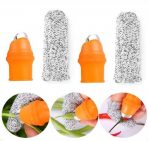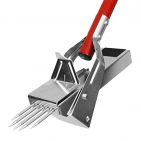by Stan Logan | Jul 14, 2020 | Garden tools, Irrigation
I think each of us battles with hoses and faucets that drip. When a faucet drips, it’s generally a leak that occurs at the base of the handle stem. You will probably notice that the handle is really easy to turn. What is supposed to seal the handle stem within the faucet is what is called a pressure washer. Over time these tend to shrink so that they no longer seal well against the stem. What you need to do is get an adjustable wrench and tighten the large nut at the base of the handle stem. This nut is probably “frozen” so you may have to use considerable force to tighten it. Hold the faucet firmly with your other hand to prevent damage elsewhere. Tighten the nut until the faucet handle is still easy to turn.
Many hose leaks occur where the hose attaches to the faucet. If you replace the rubber or plastic washer in the female fitting, your leak will generally be solved. Grab the old washer with pliers—a needle nose works best–and pull it out. Insert a new washer. If the hose end still leaks, try tightening it further. A channel lock wrench works well for this. If the leak continues, you may have to replace the female hose end. Washers and replacement hose ends are common in nurseries and hardware stores. Make sure though that you buy the proper size end replacement for your hose size—3/4”, 5/8”, or ½”. You may also choose to buy a new hose particularly if the old one is constantly kinking. Here I would advise you that you get what you pay for. Make sure that you are getting the right length to fit your needs—too much hose can be a pain also.
Now that I think of it, hose leaks frequently occur at the other end where you attach a sprayer of some kind. Here, again, the problem is generally the washer. If replacing the washer doesn’t help, check the end of the male hose fitting. If the surface that meets the washer is not smooth, you will need to flatten the end surface with a file. If the male hose end cannot be repaired, replace it noting the advice a gave you above. Of course, if the leak is within the sprayer attachment, it is time for it to go.
Stan, The Blog Man
P.S. LaVille, my editor, mentioned that the biggest problem with leaks is that your shoes get wet and can sometimes be ruined. So this is a very serious matter!

by Stan Logan | Jul 14, 2020 | Garden tools
I was out in the garden today doing maintenance. That’s my job. LaVille does the creating, and I try to do the maintaining. So I am deadheading—mainly Lantana—and it occurred to me that the job would be easier if I had a tool that would fit over my thumb and allow me to pinch off spent blooms. After lunch and the daily nap, I decided to see if there was actually such a tool, I googled “thumb garden pruner” and discovered that there were several models available. When I found they were available on Amazon, I went to the site and read over the comments on different brands. I chose a brand that offered a size option since my fingers definitely fit the large category—besides it was “Amazon’s Choice.” So my thumb knives will arrive in a couple days and I’ll give you a person evaluation.

Thumb Knives
I would give this device 4 out of 5 stars. My first problem was that I had trouble inserting my thumb. Although I ordered the “large” version, it was too snug. Perhaps it is designed for a woman’s large thumb—and indeed it fits LaVille’s thumb just fine. I measured the circumference of my thumb and it was 3 1/8 inches. Now before you call Guinness World Records, let you remind you that this is circumference. Remember how you get diameter out of circumference? Dividing 3 1/8 by 3.14, you get 1 inch. See—no freak here. So maybe that gives you some idea of the size you need. Anyway, as I tried to pull the device on, it separated. Re-attaching the two parts was a challenge, but I succeeded. The first plant I attacked was a gazania that had gone crazy with blooms. For a long time I attempted to severe the flower stalks by pinching between the thumb blade and my sleeve protected forefinger. It didn’t take too long for my forefinger to get sore. I thought that the thumb knife would be used in the same manner that I had used to deadhead by pinching my thumbnail against my forefinger. I discovered that no pinching is needed. You simply twist your wrist downward so that the knife edge presses against the stalk. So why is this device better than what you have been doing forever? First, you can cut the stalk deep in the plant by sliding your hand down the stalk. Then, since the cut stalk in already in your hand, you can simply move to another stalk without using your other hand. Also, since you are using only one hand, you don’t have to bend over as far to get both hands involved. Now I have to tell you that LaVille loves this tool. She was even using it without the forefinger sleeve. She said that in some instances she used the cutting edge to slice through a bunch of stalks she had gathered in her other hand. So she would rate the thumb knife 5 stars. If you choose to use the thumb knife, eventually it will lose its razor sharp edge. I can sharpen it for you if that ever happens. I guess I’ll have to say it’s “thumbs up” for the thumb knife.
Happy deadheading, Stan The Tool Man
by Stan Logan | Jun 22, 2020 | Design
Last year I constructed a lattice-like structure for the garden. It consisted of 2 by 4 foot metal black grids supported by 4×4 posts. I chose to use 3 grids because I knew that a odd number of items is generally preferred. The structure stood for months and every time I looked at it, it didn’t look right. I finally figured it out. The grids were nearly invisible, but the 4 posts were quite noticeable. It bothered me so much that I extended the lattice with a fifth post and additional grid. Now I’m happy . . and felt I should expound a little on this concept of displaying an odd number of features. I asked LaVille why an odd number of items is preferred over an even number. She said that I was now dealing with art. I didn’t fully understand her continued explanation. Google to the rescue: “An odd number of details is more effective at capturing your gaze. Odd numbers force your eyes to move around the grouping. That force movement is the heart of visual interest. It’s for that reason that a set of three is more appealing and memorable than something paired off in two’s.” So, if you never considered the importance of displaying plants in odd numbers—particularly 3’s, give it a try. The same principle applies to home decoration, but I’m hardly one to give advice in that realm . . but I have been watching a lot of HGTV lately.
Stan

by Stan Logan | Jun 22, 2020 | Weeds
Here is tool you may find useful. If you have a significant weed population that consists of a lot of isolated large weeds, this may be your baby. The way this tool works is that you stab the tines into the soil in front of the weed. You may push the tool deeper with your foot if necessary.

Weed Popper
Then, by pressing the lever at the back of the tool, the tines will pivot upwards and lift the weed with its root out of the soil. The Weed Popper would not be useful if your weeds are growing among valued plants, nor would you use it to remove weeds in a lawn. But let’s say you have a large property that you have protected with a generous application of mulch. Isolated weeds eventually will appear and using this tool will keep you off your knees and perhaps be easier to use than a hoe. If you google “weed popper” you can watch a video showing its use.
Oh great! It’s at this point that I tell you where to buy and how much. Guess what? As of 6/22/20, this tool is unavailable.
All right—let me give you another option:

The Fiskars 4-Claw Weeder works in a different fashion. You stab the tool over the center of a weed and press it farther with your foot. When you pull back on the handle, the 4 claws close on the root of the weed and yank it out of the soil. I have had one of these weeders for well over a year and never used it. I got it free at a garage sale. I have no large weeds, so I went over to my next door neighbor and attacked the dandelions in his lawn. I found it was extremely effective. After the weed is extracted, you slide the orange handle down and the weed pops right off. The only problem is you must hit the center of the weed in order to grab the root. I have to admit that it was fun pulling out these weeds. It was difficult to stop, but when I saw a path of dandelion carcasses all over, I realized that I had a lot of evidence to clean up. The advantage this tool has over the one above is that the weed doesn’t have to be isolated.
If you also have fun weeding, I think this may be the ideal tool to increase your joys in the garden.
The Fiskars 4-Claw Weeder is available at Amazon Prime for $41.48 or at Walmart for a few dollars less.
Happy weeding!
Stan The Tool Man
by Stan Logan | Jun 3, 2020 | Weeds
It is hard enough keeping up with the invasion of weeds in your garden without having plants conspiring against you. I am currently trying to eradicate both spurge and moss from the garden. Since both of these terrorists are tiny and prone in development, they have found an ally in baby tears. 45 years ago we bought a 4 inch pot of baby tears. Do I need to tell you more? For decades it has been a challenge keeping baby tears confined. Now to confound my frustration, they have buddied up with not only the moss, 2 species of spurge, but even the Johnny Jump-Ups have joined the conspiracy. My response to these chums is “Burn baby, burn”! You would think that the word would get out and the baby tears would stop there conniving behavior. But, no—the battle ensues on a daily basis–and will until I run out of gas.
Oh, by the way, would you like a clump of baby tears?
Stan



